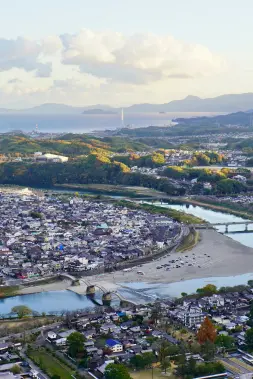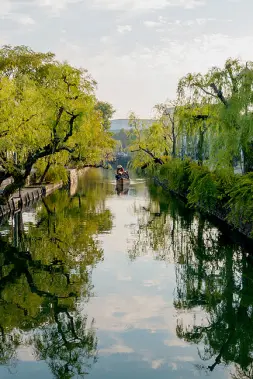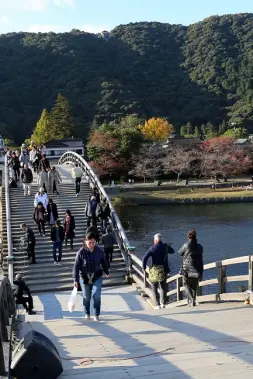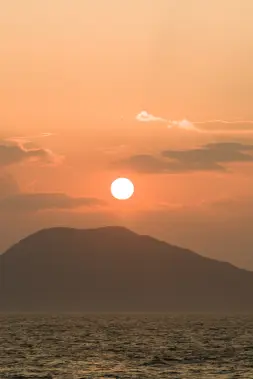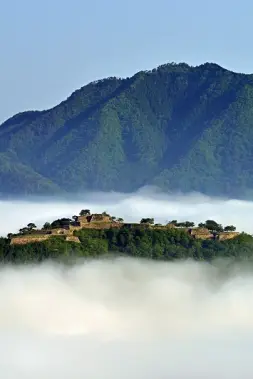Adventure & Experience
Mt. Misen Trekking and Miyajima: The Best Two-Hour Hiking Trail to Take in Japan

-
- DESTINATION NAME
- Hiroshima
-
- RELATED TAGS
-
- LAST UPDATED
- 30 April, 2021
Suppose you're looking for a light hiking expedition with stunning island and ocean views, and including prestigious Buddhist structures of deep religious and historical significance. In that case, Mount Misen (弥山) of Hiroshima prefecture checks all the boxes. As the highest peak of Hiroshima’s Miyajima Island (宮島), Mt. Misen is surrounded by the island's emblematic sites, like the iconic “floating” torii Shinto gate, Itsukushima Shrine (厳島神社), and many curious deer roaming the paths and streets of the island. One of the major schools of Buddhism in Japan was founded on this “island of shrines” in the 9th century, permanently establishing Mt. Misen as a holy mountain site beloved not only by common visitors but of Emperors of the long past.
One of the best ways to appreciate this island's beauty and religious significance is on foot, and Mt. Misen has plenty of scenic routes you can take to maximize your time in the outdoors. As I made my way up a two-hour Daisho-in hiking trail up the mountain, I came across picturesque shrines and temples from lofty forest views, curious mountainside deer, and at Mt. Misen's observatory at the peak, 360-degree views of Seto Inland Sea that (seriously) had my jaw-dropping in awe.
Three Main Hiking Trails to Take on Mt. Misen
Visitors can choose one of Mt. Misen's three official hiking trails —Momijidani Course, Daisho-in Course, and Omoto Course— up to the mountain's summit. Each hike takes approximately 1.5 to 2.5 hours to reach the peak from town. I chose the two-hour Daisho-in Course, the least steep of the three, and considered the most beautiful trail. As I wound my way up well-maintained trails shaded by gentle underbrush, with glimpses of the Seto Island Sea peeking through the forest, I can only assume this claim of beauty to be true. Whichever trail your take, your efforts will be rewarded with breathtakingly spectacular views, making this hike one of the best leisurely hiking courses you can take in Japan.
What Do I Need for My Mt. Misen Hike?
Before you start your trek, be sure to pick up something for lunch like a bento box, snacks, and drinks for your hike, as there are no restaurants or snack bars along the paths.
Daisho-in Temple: Western Japan’s Early Buddhist History
Before starting my hike up the Daisho-in trail, I visited Daisho-in Temple (大聖院) at the base of Mt. Misen, where I got a crash course on the mountain's various temples and religious narrative. Kobo Daishi was the founder of the Shingon sect of Buddhism who brought esoteric Buddhism from Tang China in the 800's. In 806, he conducted ascetic practices for 100 days in the wilderness of Mt.Misen.
At the entrance is the Niomon Gate, where two Nio guardians of Buddha stand guard to repeal any evil from entering beyond its gates. Respecting for the Buddha, I took a deep bow, then headed up the steps to the main complex, where a booming chant and drum resounded. These daily chants of the monks accompany visitors' prayers for good health and longevity, amplified by speakers from the Kannon-do Hall, which houses a colorful sand mandala made by Buddhist monks from Tibet.
The upper halls are Maiden Hall and eponymous Daishi-do Hall, where Kobo Daishi himself is enshrined. Underneath the Daishi-do Hall is Henjyokutsu Cave, brought to life with glowing lanterns and eighty-eight Buddhist icons representing the prestigious 88 temples along the Shikoku pilgrimage route. Sand collected from each temple site is buried under its corresponding statue, and it is believed that if you pray at each figure, you'll be given the same blessings as you would if you made the pilgrimage to all the temples on the route.
Even from Daisho-in Temple, there are peeks of the Seto Inland Sea's ultramarine water — a teaser of what is still to come.
Daisho-in Hiking Course: Trekking the Sacred Mountain of Mount Misen
After leaving Daisho-in Temple, I started on the Daisho-in Course running parallel to the temple complex. The small Shiraito Waterfall and shrine immediately came into view as I made my way up manicured trails and stone stairways through the Mt. Misen forest. Other than a few other hikers making their descent from the mountain, I had the course almost to myself, giving me ample opportunity to occasionally stop to admire the increasingly soaring views of the Seto Inland Sea that peeked through the forest.
Keep your eyes peeled for the shy deer that live on Mt. Misen along your hike. If you're lucky, you may get a rare glimpse of wild monkeys that used to live in great numbers on the mountain before they were moved off the island due to overpopulation.
Niomon Gate and Miyama Shrine
After a leisurely hour of hiking, I arrived at the upper half of my Daisho-in course at two ornately rendered Nio guardians at Niomon Gate. Just beyond these rosy-colored guardians are the modestly-sized vermillion structures of Miyama Shrine. If you time your visit just right, as I fortuitously did, the wind will carry the town's noontime song up to the top of the mountain while you take in the epic views of the seascape below. As the triumphantly optimistic music reached ears on the cliffside viewpoint, I felt a sense of accomplishment for the hike I completed so far.
Misen Hondo and Reikado, the Hall of the Spiritual Flame
Located a short distance from the summit are a collection of great halls, including Misen Hondo (Misen Main Hall) and the Reikado (Hall of the Spiritual Flame). Reikado Hall protects a flame said to have been lit by Kobo Daishi himself when he came to worship on Mt. Misen, making it over 1,200-years-old! This sacred flame was one of many used to light the Flame of Peace in Hiroshima's Peace Park.
The adjacent Misen Hondo enshrines Kokuzo Bosatsu, the deity of luck and wisdom, and is one of three places in Japan where Shingon Buddhism is taught. Just when I started to believe I wouldn't encounter the mountain's elusive deer, they appeared from the trees and accompanied me up to Sankido Temple, where three fierce guardian gods of Mt. Misen are enshrined.
Mt. Misen Summit and Observatory
The effort I made to reach Mt. Misen's summit felt trivial compared to the spectacular views I was rewarded with at the end of my hike. The entire Seto Inland Sea unfolded in a panoramic view as I passed under giant rock pillar tunnels and along walkways up to the Mt. Misen Observatory. These views have garnered the Michelin Green Guide three stars, which doesn't surprise me. Views of glimmering turquoise blue waters capped white-sand beaches, rounded islands dotting the inland sea, and the orderly lines of fish farms deservedly earn the distinction of the Michelin green guide stars.
The Mt. Misen observatory has the best of these views, with a wrap-around terrace and plenty of space to enjoy your bento box lunch (remember to prepare your lunch in advance) while taking in the scenery. The observatory's top floor has the best views, with unbroken 360-degree views of the sights, where a fellow hiker pointed out the faint outline of Shikoku in the distance.
In case you're looking for a more leisurely way back down from the summit, the Mt. Misen ropeway is approximately a one-kilometer hike down from the peak, with aerial views of the mountain foliage as you take the relaxing trip down the mountain. Whichever way your path takes you, this hike guarantees a perfect mixture of theological history complemented with equally stunning views. If this is the only activity you have time for on Miyajima, this hike up Mt. Misen will collectively impress and inspire you to seek more treasures hidden within the Setouchi region.
How to Get to Miyajima
From Hiroshima Station, take the JR Sanyo Line to Miyajimaguchi Station, then walk to the ferry pier where you can catch either a JR or Matsudai ferry for a 10-minute ride to Miyajima. You can also catch a 45-minute long ferry ride from the Hiroshima Peace Park.To Hiroshima station, it takes about 1 hour and 15 minutes from Kyoto Station or Shin-Osaka Station, and about 4 hours from Tokyo Station.
There are also domestic flights from Haneda or Narita to Hiroshima Airport (about 1 hour and 40 minutes).
Things to See and Do in the Miyajima
Miyajima Nature Park has campsites, cabins, and BBQ facilities to extend your outdoor experience of Miyajima. Test your balance on Miyajima's waters while SUP (Stand-up paddleboarding), where you'll be able to get up close and personal with the famous floating torii gate.
Photographs and text by Mika Senda
RELATED DESTINATION
Hiroshima
Hiroshima is the central city of Chugoku region. Hiroshima Prefecture is dotted with Itsukushima Shrine, which has an elegant torii gate standing in the sea; the Atomic Bomb Dome that communicates the importance of peace; and many other attractions worth a visit. It also has world-famous handicrafts such as Kumano brushes.











































